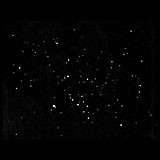
| MESSIER 47 |
|---|
RA: |
07h 36m 36s |
|
DEC: |
-14° 29' 00'' |
|
Type: |
Open cluster |
|
NGC: |
2422 |
|
Magnitude: |
5.20 |
|
Surface brightness : |
||
Apparent dimensions : |
30'x30' |
|
Distance: |
1,600 ly |
|
M47 was discovered before 1654 by Hodierna who described it as "a Nebulosa between the two dogs". Charles Messier discovered this cluster independently on February 19, 1771, and described it as cluster of stars brighter than those of apparently neighbored M46.But Messier did a sign error when computing the position of M47, so that it was a missing object until 1959 when it was identified. It is interesting that despite Messier's error, Caroline Herschel observed and identified M47 at least twice in early 1783. Several historians have reported that M47 had been previously identified by Oswald Thomas in 1934, but this is apparently a confusion with that author's identification of M48. As a consequence of Messier's error, William Herschel also independently rediscovered it on February 4, 1785, and gave it the number H VIII.38. Open cluster M47 is a coarse cluster of bright stars, and contains about 50 stars in a region 12 light years in diameter; in the central portion, the stellar density is about 16 stars per cubic parsec while the average density of the whole cluster is only 0.62 stars per cubic parsec. Its distance is about 1,600 light years, so that the stars of M47 appear scattered over an area in the sky of the same size as the full moon, 30 arc minutes. The brightest star is of spectral class B2 and mag 5.7, the overall population resembles that of the Pleiades. It also contains two orange K giants with luminosity of about 200 times that of the Sun each. The Sky Catalog 2000 gives an estimated age of 78 million years for this stellar swarm which is receding from us at 9 km/sec. |
||
VEDRAN VRHOVAC© 2006.-2007. |
